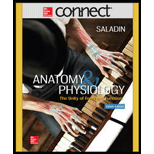
CONNECT ACCESS CARD FOR ANATOMY AND PHYSIOLOGY
8th Edition
ISBN: 9781259880193
Author: SALADIN
Publisher: MCGRAW-HILL HIGHER EDUCATION
expand_more
expand_more
format_list_bulleted
Question
Chapter 26, Problem 6WWTS
Summary Introduction
Introduction:
Excessive production of
Expert Solution & Answer
Want to see the full answer?
Check out a sample textbook solution
Students have asked these similar questions
Stage
Percent
Time in Hours
Interphase
.60
14.4
Prophase
.20
4.8
Metaphase
.10
2.4
Anaphase
.06
1.44
Telophase
.03
.72
Cytukinesis
.01
.24
Can you summarize the results in the chart and explain which phases are faster and why the slower ones are slow?
Can you circle a cell in the different stages of mitosis?
1.prophase
2.metaphase
3.anaphase
4.telophase
5.cytokinesis
Which microbe does not live part of its lifecycle outside humans?
A. Toxoplasma gondii
B. Cytomegalovirus
C. Francisella tularensis
D. Plasmodium falciparum
explain your answer thoroughly.
Chapter 26 Solutions
CONNECT ACCESS CARD FOR ANATOMY AND PHYSIOLOGY
Ch. 26.1 - Prob. 1AYLOCh. 26.1 - Prob. 2AYLOCh. 26.1 - Prob. 3AYLOCh. 26.1 - Prob. 4AYLOCh. 26.1 - Roles of the arcuate nucleus, neuropeptide YY, and...Ch. 26.1 - Prob. 6AYLOCh. 26.1 - Prob. 7AYLOCh. 26.1 - Prob. 8AYLOCh. 26.1 - Principal dietary sources of calories; the...Ch. 26.1 - Prob. 10AYLO
Ch. 26.1 - Prob. 11AYLOCh. 26.1 - Prob. 12AYLOCh. 26.1 - Prob. 13AYLOCh. 26.1 - Prob. 14AYLOCh. 26.1 - Prob. 15AYLOCh. 26.1 - Prob. 16AYLOCh. 26.1 - Prob. 17AYLOCh. 26.1 - Prob. 18AYLOCh. 26.1 - Prob. 19AYLOCh. 26.1 - Prob. 20AYLOCh. 26.1 - Prob. 21AYLOCh. 26.1 - Prob. 22AYLOCh. 26.1 - Type of lipoproteins found in the...Ch. 26.1 - Prob. 24AYLOCh. 26.1 - Prob. 25AYLOCh. 26.1 - Prob. 26AYLOCh. 26.1 - Prob. 27AYLOCh. 26.1 - Prob. 28AYLOCh. 26.1 - Prob. 29AYLOCh. 26.1 - Prob. 30AYLOCh. 26.1 - Prob. 1BYGOCh. 26.1 - Prob. 2BYGOCh. 26.1 - What class of nutrients provides most of the...Ch. 26.1 - Prob. 4BYGOCh. 26.1 - Prob. 5BYGOCh. 26.2 - Prob. 1AYLOCh. 26.2 - Function of the coenzymes NAD+ and FAD in glucose...Ch. 26.2 - Prob. 3AYLOCh. 26.2 - Anaerobic fermentation and its primary purposeCh. 26.2 - Prob. 5AYLOCh. 26.2 - Prob. 6AYLOCh. 26.2 - Prob. 7AYLOCh. 26.2 - Prob. 8AYLOCh. 26.2 - The net ATP yield of glycolysis and aerobic...Ch. 26.2 - The efficiency of aerobic respiration and how to...Ch. 26.2 - How excess glucose is convened to glycogen; the...Ch. 26.2 - Prob. 6BYGOCh. 26.2 - Prob. 7BYGOCh. 26.2 - Prob. 8BYGOCh. 26.2 - Prob. 9BYGOCh. 26.2 - What important enzyme is found in the inner...Ch. 26.2 - Prob. 11BYGOCh. 26.3 - What cells are primarily responsible for storing...Ch. 26.3 - The process of lipolysis including the hydrolysis...Ch. 26.3 - Prob. 3AYLOCh. 26.3 - Prob. 4AYLOCh. 26.3 - Prob. 5AYLOCh. 26.3 - Prob. 6AYLOCh. 26.3 - Prob. 7AYLOCh. 26.3 - How the liver produces ureaCh. 26.3 - Other nondigestive functions of the liverCh. 26.3 - Prob. 12BYGOCh. 26.3 - Prob. 13BYGOCh. 26.3 - Prob. 14BYGOCh. 26.4 - Prob. 1AYLOCh. 26.4 - Prob. 2AYLOCh. 26.4 - When the body is in its postabsorptive state; what...Ch. 26.4 - Hormones that regulate the postabsorptive state,...Ch. 26.4 - Prob. 5AYLOCh. 26.4 - Prob. 6AYLOCh. 26.4 - Prob. 15BYGOCh. 26.4 - Prob. 16BYGOCh. 26.4 - Prob. 17BYGOCh. 26.4 - Prob. 18BYGOCh. 26.5 - Prob. 1AYLOCh. 26.5 - Prob. 2AYLOCh. 26.5 - Prob. 3AYLOCh. 26.5 - Prob. 4AYLOCh. 26.5 - Prob. 5AYLOCh. 26.5 - Prob. 6AYLOCh. 26.5 - Prob. 7AYLOCh. 26.5 - Prob. 8AYLOCh. 26.5 - Prob. 9AYLOCh. 26.5 - Prob. 19BYGOCh. 26.5 - Prob. 20BYGOCh. 26.5 - Prob. 21BYGOCh. 26.5 - Prob. 22BYGOCh. 26 - Prob. 1TYRCh. 26 - Prob. 2TYRCh. 26 - Prob. 3TYRCh. 26 - The lipoproteins that remove cholesterol from the...Ch. 26 - Which of the following is most likely to make you...Ch. 26 - Prob. 6TYRCh. 26 - FAD is reduced to FADH2 in a. glycolysis. b....Ch. 26 - Prob. 8TYRCh. 26 - Prob. 9TYRCh. 26 - Prob. 10TYRCh. 26 - Prob. 11TYRCh. 26 - Prob. 12TYRCh. 26 - Synthesis of glucose from amino acids or...Ch. 26 - Prob. 14TYRCh. 26 - Prob. 15TYRCh. 26 - Prob. 16TYRCh. 26 - Prob. 17TYRCh. 26 - The appetite hormones ghrelin, leptin, CCK, and...Ch. 26 - The brightly colored, iron-containing,...Ch. 26 - Prob. 20TYRCh. 26 - Prob. 1BYMVCh. 26 - Prob. 2BYMVCh. 26 - Prob. 3BYMVCh. 26 - Prob. 4BYMVCh. 26 - Prob. 5BYMVCh. 26 - Prob. 6BYMVCh. 26 - Prob. 7BYMVCh. 26 - Prob. 8BYMVCh. 26 - Prob. 9BYMVCh. 26 - Prob. 10BYMVCh. 26 - Prob. 1WWTSCh. 26 - Prob. 2WWTSCh. 26 - Prob. 3WWTSCh. 26 - Most of the body's cholesterol comes from the...Ch. 26 - Prob. 5WWTSCh. 26 - Prob. 6WWTSCh. 26 - Prob. 7WWTSCh. 26 - Prob. 8WWTSCh. 26 - Prob. 9WWTSCh. 26 - Prob. 10WWTSCh. 26 - Prob. 1TYCCh. 26 - Chapter 17 defines and describes some hormone...Ch. 26 - Prob. 3TYCCh. 26 - A Television advertisement proclaims. "Feeling...Ch. 26 - Explain why a patient whose liver has been...
Knowledge Booster
Similar questions
- Select all of the following that the ablation (knockout) or ectopoic expression (gain of function) of Hox can contribute to. Another set of wings in the fruit fly, duplication of fingernails, ectopic ears in mice, excess feathers in duck/quail chimeras, and homeosis of segment 2 to jaw in Hox2a mutantsarrow_forwardSelect all of the following that changes in the MC1R gene can lead to: Changes in spots/stripes in lizards, changes in coat coloration in mice, ectopic ear formation in Siberian hamsters, and red hair in humansarrow_forwardPleiotropic genes are genes that (blank) Cause a swapping of organs/structures, are the result of duplicated sets of chromosomes, never produce protein products, and have more than one purpose/functionarrow_forward
- A loss of function mutation in Pitx1 enhancers can cause (blank) Removal of Pitx1 exons and growth of ectopic hindlimbs, growth of extra ectopic forelimbs, loss of forelimb specification and development, and loss of hindlimb specification and developmentarrow_forwardHox1a most likely contributes to (blank) patterning in the developing embryo? Ventral, posterior, limb or anteriorarrow_forwardSelect all of the following that can help establish Hox gene expression boundaries (things that affect Hox and not things that Hox affects). Retinoic acid, anterior/posterior axis, fibroblast growth factors, vagal neural crest, and enhancersarrow_forward
- Ectopic expression of Hox often results in (blank) phenotypes. (Blank) transformations are characterized by the replacement of one body part/structure with another. Hoxeotic, homealoneotic, joexotic, or homeoticarrow_forwardWhat's the difference when drawing omega-6 and omega-3?arrow_forward. Consider a base substitution mutation that occurred in a DNA sequence that resulted in a change in the encoded protein from the amino acid glutamic acid to aspartic acid. Normally the glutamic acid amino acid is located on the outside of the soluble protein but not near an active site. O-H¨ A. What type of mutation occurred? O-H B. What 2 types of chemical bonds are found in the R-groups of each amino acid? The R groups are shaded. CH2 CH2 CH2 H2N-C-COOH H2N-C-COOH 1 H Glutamic acid H Aspartic acid C. What 2 types of bonds could each R-group of each of these amino acids form with other molecules? D. Consider the chemical properties of the two amino acids and the location of the amino acid in the protein. Explain what effect this mutation will have on this protein's function and why.arrow_forward
- engineered constructs that consist of hollow fibers are acting as synthetic capillaries, around which cells have been loaded. The cellular space around a single fiber can be modeled as if it were a Krogh tissue cylinder. Each fiber has an outside “capillary” radius of 100 µm and the “tissue” radius can be taken as 200 µm. The following values apply to the device:R0 = 20 µM/secaO2 = 1.35 µM/mmHgDO2,T = 1.67 x 10-5 cm2/secPO2,m = 4 x 10-3 cm/secInstead of blood inside the fibers, the oxygen transport and tissue consumption are being investigated by usingan aqueous solution saturated with pure oxygen. As a result, there is no mass transfer resistance in the synthetic“capillary”, only that due to the membrane itself. Rather than accounting for pO2 variations along the length ofthe fiber, use an average value in the “capillary” of 130 mmHg.Is the tissue fully oxygenated?arrow_forwardMolecular Biology Please help with question. thank you You are studying the expression of the lac operon. You have isolated mutants as described below. In the presence of glucose, explain/describe what would happen, for each mutant, to the expression of the lac operon when you add lactose AND what would happen when the bacteria has used up all of the lactose (if the mutant is able to use lactose).5. Mutations in the lac operator that strengthen the binding of the lac repressor 200 fold 6. Mutations in the promoter that prevent binding of RNA polymerase 7. Mutations in CRP/CAP protein that prevent binding of cAMP8. Mutations in sigma factor that prevent binding of sigma to core RNA polymerasearrow_forwardMolecular Biology Please help and there is an attached image. Thank you. A bacteria has a gene whose protein/enzyme product is involved with the synthesis of a lipid necessary for the synthesis of the cell membrane. Expression of this gene requires the binding of a protein (called ACT) to a control sequence (called INC) next to the promoter. A. Is the expression/regulation of this gene an example of induction or repression?Please explain:B. Is this expression/regulation an example of positive or negative control?C. When the lipid is supplied in the media, the expression of the enzyme is turned off.Describe one likely mechanism for how this “turn off” is accomplished.arrow_forward
arrow_back_ios
SEE MORE QUESTIONS
arrow_forward_ios
Recommended textbooks for you
 Nutrition Through The Life CycleHealth & NutritionISBN:9781337919333Author:Brown, Judith E.Publisher:Cengage Learning,
Nutrition Through The Life CycleHealth & NutritionISBN:9781337919333Author:Brown, Judith E.Publisher:Cengage Learning, Human Physiology: From Cells to Systems (MindTap ...BiologyISBN:9781285866932Author:Lauralee SherwoodPublisher:Cengage Learning
Human Physiology: From Cells to Systems (MindTap ...BiologyISBN:9781285866932Author:Lauralee SherwoodPublisher:Cengage Learning- Lifetime Physical Fitness & WellnessHealth & NutritionISBN:9781337677509Author:HOEGERPublisher:Cengage

Nutrition Through The Life Cycle
Health & Nutrition
ISBN:9781337919333
Author:Brown, Judith E.
Publisher:Cengage Learning,


Human Physiology: From Cells to Systems (MindTap ...
Biology
ISBN:9781285866932
Author:Lauralee Sherwood
Publisher:Cengage Learning


Lifetime Physical Fitness & Wellness
Health & Nutrition
ISBN:9781337677509
Author:HOEGER
Publisher:Cengage
